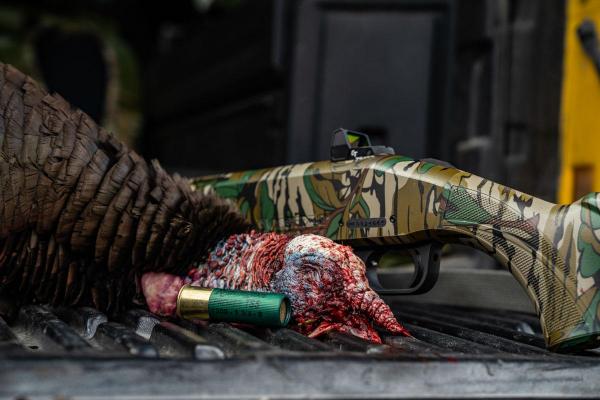Ensure that your shotgun puts pellets in a dense pattern downrange
About this time every year turkey hunters gather and tell the stories of the one that got away. There are lots of reasons turkey hunters are unsuccessful, but maybe the most disappointing reason is because of a miss.
After all, with today’s high-tech turkey killing shotshells, costing as much as $14 each, you’d think missing turkeys would be a thing of the past.
Well, it’s not. Of course, some miss their bird because they get excited and shoot poorly. But why do some turkeys escape unharmed even when the hunter seems to have done everything right?
The Proper Zero
One reason turkeys seem to be able to slip through the cloud of shot sent their way is because hunters fail to properly pattern their shotguns.
Now, when it comes to patterning, there are several approaches.
Turkey hunters seem to want ultra-tight patterns, and that’s why there’s such a lucrative market associated with aftermarket choke tubes.
With extremely tight patterns the effective range of a shotgun can be extended.
This of course is a good thing, but at the same time it creates the problem of missing at close range. It also amplifies the importance of a proper zero.
One approach to patterning a shotgun for turkey hunting is to shoot at a quartered patterning target. A patterning target has a large circle dissected by two lines through its center.


After it has been shot, you count the number of holes in each quarter. Ideally, these four quarters should have about the same number of holes. When that happens turkey hunters assume their shotgun is delivering a good pattern.
To some extent this is true, but what this evenly distributed pattern of shot really means, is that their shotgun is properly zeroed. In other words, it is delivering the center of the pattern to the center of the target.
The proper zero is important, especially at close range where the pattern diameter can be small.
Many of today’s turkey hunters use optical sights and this makes zeroing easier.
However, with older shotguns that only have a single bead sight, sight adjustment is not an option, and you may need to hold off to get that pattern to land on the spot – the turkey’s head – you want to hit.
Also, regardless the sight, the repetitive shooting of 3- or 3.5-inch magnum loads can become extremely unpleasant.
This repeated pounding can make good shooting difficult.
Take your time and don’t rush the process.
Pattern Evaluation
The best way to evaluate a shotgun pattern is to look at it from the standpoint of what is not being hit. During World War II, aircraft engineers examined the damage to airplanes that returned from missions.
They looked at where they were receiving the most damage and initially thought those areas needed reinforced. What was really happening was survivorship bias.
The areas that received the most damage were not important areas – that’s why the planes survived. The planes that did not survive were the ones receiving damage in the other locations.
This loosely correlates to shotgun patterning.
When you look at a shotgun pattern, look to see what’s not being hit.
These gaps in the pattern are what can allow a turkey to seemingly survive a storm of hundreds of pellets. When evaluating a shotgun pattern for turkey hunting, start somewhere between 25 and 35 yards.


Fire a single shot and look at the gaps.
Take a lid off a gallon of milk and look on the pattern to see where that lid can be placed so that it does not cover any holes. Ideally, a gapless area of about 8- to 12-inches is what you’re looking for.
If you can find that at 25 yards, try again at 30 yards and even further out.
When you get to a distance where these gaps become frequent, you’ve found your maximum effective range for that load/choke combination.
The final step you need to take is to adjust your sights, so they are pointing to the center of this gapless shot pattern. At 35 or 40 yards your pattern might be 24-inches in diameter or even larger.
The size of the pattern is not as important as the eight-inch or so diameter gapless area.
Find the load that gives you this consistent gapless pattern at the furthest distance, and then zero your shotgun – or learn to hold – so that this area of the pattern can be delivered at the precise spot you want it.
With all this done, all that remains is for you to do your part when the moment of truth comes.
Don’t take shots past your maximum effective range, make sure you hold on the right spot, and don’t jerk the trigger.
Then, you won’t be telling stories about the turkey you missed, you’ll be listening to others tell of their disappointment.
